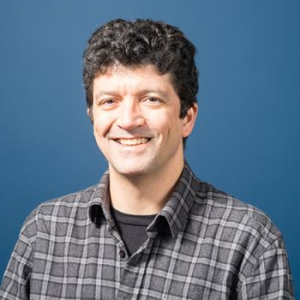Research Areas: Galaxy formation, Observational astronomy
"I consider myself extremely lucky to be where I am, do what I do, and to be surrounded by so many amazing people here in Liverpool."

Early Life
Ricardo was born in Rio de Janeiro, Brazil. His first degree in astronomy is from the Federal University of Rio de Janeiro. Then in 1993, he got a master's degree from the Observatório Nacional in Brazil. Ricardo moved to the University of São Paulo, Brazil to work on a PhD. He was awarded his PhD in 1998.
Career Highlights
Ricardo has worked on lots of different topics in astrophysics. He has spent a lot of time looking at the atmospheres of young stars called T Tauri stars. These “baby Suns” are less than 10 million years old, that. This means they look the way our Sun did 4.6 billion years ago.
Ricardo has also studied huge groups of stars called galaxies. These are billions of light-years from Earth. His work has mainly looked at a type of galaxy called elliptical. These are ball-shaped galaxies with 10 thousand billion stars inside them! These galaxies are also very old. They made their stars a long time ago and now have very little gas and dust in them.
One of the methods Ricardo uses to look at objects in space is molecular spectroscopy. This sees how light reacts with the smallest particles in dust and gas. It splits light into all of its various wavelengths.
Ricardo has spent a lot of time in the USA, both at telescopes and colleges. From 1999 to 2003 he was at the Lick Observatory in California. He then spent four years at the University of Virginia. After Virginia, he moved to the Gemini Observatory in Hawaii. He was an astronomer there for 5 years. Ricardo is now at Liverpool John Moores University in the UK. He teaches students and carries out research.
Ricardo uses telescopes both on Earth and in space to look at stars and galaxies. As well as telescopes, Ricardo uses computers to do his research. These can simulate the objects and conditions he finds in space. He can then study the results of these models. The results help Ricardo to answer his research questions. Questions like, how do galaxies form? How do they change over time? Is our own Milky Way galaxy rare?
Ricardo helps to lead massive surveys of stars. These look at millions of stars in our own Milky Way galaxy. They measure what the stars are made of, and how the stars move inside the galaxy. Scientists then use these surveys to try to learn how the Milky Way formed and changed with time. They can also help us to understand how elements in the Universe were made.
Legacy
In 2020, Ricardo was one of the world’s most referenced scientists! He was in the top 2% of all scientists from around the globe. This score counts how many times other scientists used his work to help with their own research. His high score shows how much other scientists rely on the work he has done.
Ricardo is a member of astronomical societies in the USA and Brazil. He has been a part of many professional committees.
Other Interests
Ricardo likes to do lots of things in his spare time. He keeps fit by playing football and running after his 2 boys in the park. He loves music, books, history, politics, sport, and time with his family. But not always in that order!
